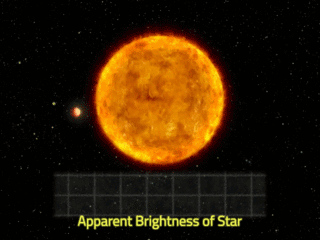If exoplanets are a gold rush, then newly discovered TOI-2180 b is like a 24-karat nugget.
Exoplanets are everywhere. NASA assumes there are 100 billion in the Milky Way alone, but fewer than 5,000 have been found so far. The first exoplanets were confirmed in the 1990s. That makes exoplanet research “one of the most fresh and exciting fields in what’s possibly the oldest science in humanity,” said Paul Dalba, a planetary astronomer at University of California, Riverside. “Exoplanet [research] is kind of in this gold rush phase.”
If exoplanets are a gold rush, then newly discovered TOI-2180 b is like a 24-karat nugget. The gas giant is a rare find because of its long orbit (261 days), its close range (379 light-years from Earth), and the relative improbability of finding it in the first place. If not for a team of planet-hunting hobbyists, the exoplanet might still be undetected.
Hunting for Treasure

The first evidence of the exoplanet came courtesy of TESS, NASA’s Transiting Exoplanet Survey Satellite. Launched in 2018, TESS looks for repeated dips in starlight that may indicate planets passing between their stars and Earth. This method—the transit method—is the most popular way to confirm exoplanets’ existence, but it can work only when everything aligns. In this case, TESS needed to be pointed at the exoplanet at the same time it transited in front of its star. The satellite focuses on a slice of the sky for only a month at a time, though, so a planet that takes more than a month to orbit its star may go undetected.
TESS also relies on repeat dips in brightness to flag a possible planet, as single dips could be triggered by the satellite or the star. By prioritizing repeat observations, the algorithm reduces false positives but mostly catches the short-orbit planets that transit most often. Amateur astronomers who know what to look for can sift through NASA data for long-orbit exoplanets and single-transit gems.
It’s like “another form of treasure hunting,” said planet-finding enthusiast Tom Jacobs in an email. Jacobs, a former U.S. naval officer, is part of a hobby planet-hunting crew called the Visual Survey Group (VSG) that looks for missed opportunities in TESS’s algorithm. The group was the first to notice TOI-2180 b in the data. They alerted Dalba, who plugged the coordinates into the aptly named Automated Planet Finder at California’s Lick Observatory. Sure enough, its star showed a regular cadence of gravitational tugs that indicated the presence of a hidden exoplanet. Dalba determined the planet’s mass, narrowed the potential transit to an 11-day window, and arranged for 14 observatories on three continents to help confirm the planet. When the professionals published their findings in the Astronomical Journal, Jacobs and his VSG team appeared among the international coauthors. It was VSG’s 68th peer-reviewed publication.

Space Stats
The team confirmed that in addition to being relatively close to Earth, the exoplanet has two important features: a long orbit and a large mass. Independently, the planet’s 261-day orbit is nothing noteworthy, but the fact that it’s a long orbit and can be seen passing in front of its star from Earth is unique, said Dalba.
A giant planet with a short orbit is easy to find with the transit method, so most of the exoplanets that have been confirmed so far are close orbiters. But that’s misrepresentative, said Heather Knutson, a professor of planetary science at the California Institute of Technology who was not involved in the research, because astronomers assume that other systems are arranged like ours, with gas giants like Jupiter orbiting farther from their stars.
“We’d ideally like to study gas giant planets [like TOI-2180 b] that are further out because we think that’s preferentially where they form,” said Knutson. Thankfully, TOI-2180 b should be relatively easy to study, because at 379 light-years away, the planet’s star shines bright from Earth and “photons are information,” noted Dalba.
TOI-2180 b’s mass has also raised eyebrows. It’s roughly the same size as Jupiter, but 3 times its mass and 105 times the mass of Earth. Its heavy mass is due to its makeup of heavy elements, which is uncommon among gas giants and may help astronomers better understand how these planets develop. The planet’s composition is curious, said Dalba, “because it suggests that maybe there are pretty interesting differences in how this giant planet formed compared to how Jupiter formed.”
The Stars Aligned
TOI-2180 b’s discovery may not have happened without collaboration between crowdsourced science and academics. The VSG team had time to manually sift through data, and Dalba and his colleagues had resources to confirm their finds.
“Personally, I feel very grateful to be able to be part of this discovery effort,” Jacobs said. Veteran astronomers do the heavy lifting, he said, while his team looks for planets that computer algorithms might have missed.
“There is a very thin line between what they do and just being astronomers,” Dalba said of Jacobs and his team of amateur astronomers. “It’s an amazing honor for me to work with them.”
TOI-2180 b’s most recent transit occurred in early February, and once again, luck was on the astronomers’ side. TESS was aimed at TOI-2180 b’s section of the sky and recorded the transit at a greater resolution than any Earth-bound observatory could, providing even more information on the unique gas giant.
—J. Besl (@J_Besl), Science Writer

